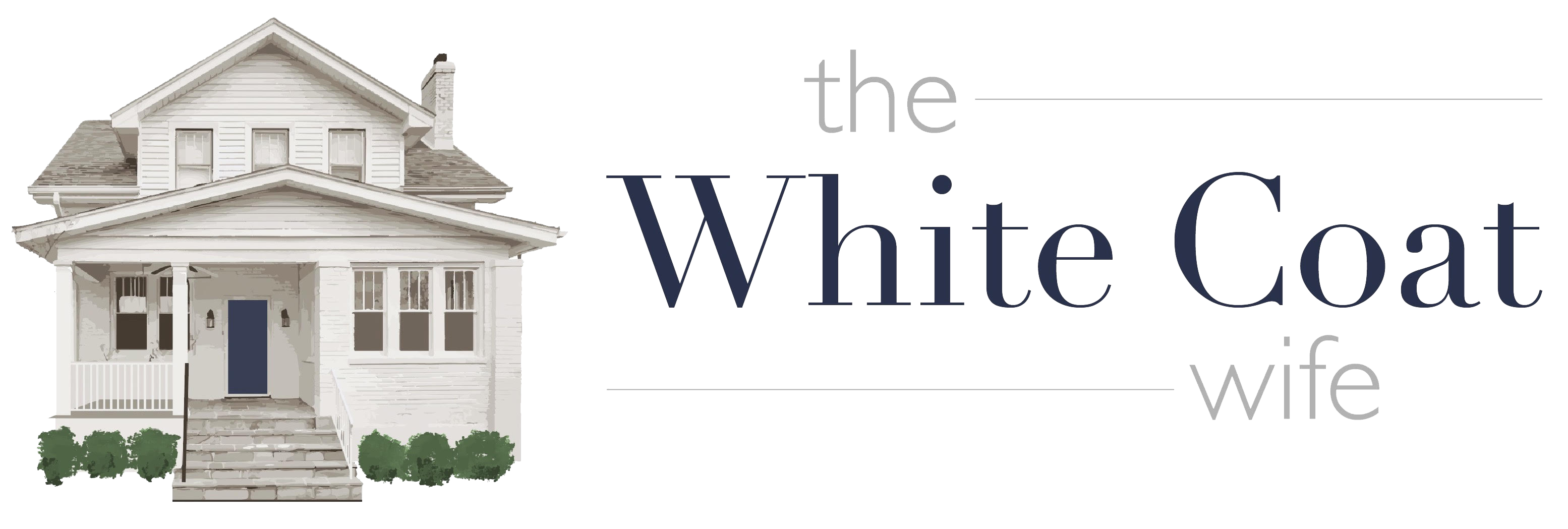My husband’s first rotation was night shift on the COVID unit in July. Nothing says welcome to the first year out of medical school in internal medicine like a viral pandemic.
Our closest friends and family often don’t realize the ins and outs of life of our calling to medicine. There are doctor wife memes that are shared among our “hive” that help us laugh and feel less misunderstood. Just as I don’t fully understand the ins and outs of the life of a military officer or pastor, I don’t expect others to fully understand ours. But listening for understanding is always helpful! As someone whose mission is to advocate for you and your family’s health, I’ve been very slow and sparse with sharing our family’s experience during the COVID pandemic, but as numbers continue to rise in the United States it seems like the appropriate time.
Any virus can make us feel helpless! Waiting it out is basically our only option. Viruses affect people differently. Those with weakened immune systems likely will experience more severe symptoms as their bodies don’t have the strength of the healthier members of the population to fight it quickly.
Since the majority of the population isn’t severely affected it’s easy for the majority to dismiss the effect or to fall into entitlement of comfort. For example, through COVID-19 mask requirements have been a tension for some. The issue at hand isn’t whether a homemade mask or paper mask is as effective in preventing the spread of droplets as a fitted N-95, it’s a bigger, much bigger, issue.
Let’s take a look at the 30,000 foot bigger picture of the COVID-19 viral pandemic.
As COVID-19 numbers rise the amount of critically ill patients rise too. Some areas of the country don’t have the proper medical facility to care for COVID-19 patients. Hospitals that have the beds and resources to support COVID-19 patients are then filling up. Non-COVID-19 patients are waiting in the ER for days without a bed. Hospitals are short staffed as the number of critically ill COVID-19 patients rises and more staff are pulled from other floors. Big picture, the impact on care of patients goes beyond the COVID-19 unit.
Speed limits are put into place to reduce the number of casualties in car accidents. Social distancing mandates have been put in place to reduce the number of critically ill patients with COIVID-19.
With fake or misinterpreted news floating around, let’s remember: physicians take a Hippocratic Oath and have years of training. In an era where Googling and self diagnosing on WebMD has become popular, we need to remember the average physician spends 10-14 years in training to become fully licensed. And this training isn’t open to the masses. For my husband there were 160 students accepted out of 7,000 applicants to his medical school and less than a percent of applicants applying to his residency program were accepted. The process to become a doctor is rigorous and a position held by well rounded, intelligent individuals. These doctors spend those years learning how to interpret scientific studies, learning how to diagnose based on pathophysiology and clinical expertise not just a superficial knowledge of symptoms. Did you know that a lung X-ray of a patient with COVID-19 looks completely distinct from those of most with bacterial pneumonia? Rather then discrediting a professional career that takes not only decades of study but also an incredible financial sacrifice, let’s leave criticism behind and give the benefit of the doubt that these women and men in white coats are giving their best to fight this pandemic.
How is this pandemic personally impacting our family? Glad you asked 😉
My husband is an internist, which means he is the doctor that treats those who are hospitalized and are neither in the ER or there for surgery. He treats the very sick. And because of a global pandemic he is the first responder for those hospitalized by COVID-19. It didn’t surprise us that he was serving COVID wards in July when residency started, but here we are in November, six months later, and he has worked two additional months in COVID wards that were not on the original schedule. This takes away from gaining experience in other areas. Working COVID wards means long days, 6am-9pm somedays. The critical nature and unpredictability of this virus for some people, means patient care is an all shift focus. No break for lunch and dinner; working and eating is required. No breaks to even enjoy a brief walk in the sunlight. The physicians serving in the ICU unit have to be ON all the time. For our internal medicine residency the schedule is four weeks of hospital work and then one week of clinic. In those four weeks there are only four total days off…6 days of work = 70+ hours a week. Plus add on changing in and out of hazmat suits. Though he really enjoys his job, being at work and having limited free time is the reality for this season.
The emotional side of this pandemic for doctors on the frontlines is another aspect that is above and beyond the normal duties of an internist. Loved ones are limited by glass or phone call to say goodbye to their loved ones. Countless conversations between the doctor and families over the next steps for their loved one are happening not in person but over the phone. A friend in another state just lost her father to COVID. She had to say goodbye via glass and a phone held to him. It’s devastating. It is disrupting the grieving process for so many. And helping these families grieve differently is now part of the roll that is now placed on my husband and others in his position.
Our toddlers don’t quite understand Dad’s schedule. How can they!? In the past, we took meals to dad at work so the kids could understand Dr. Dad’s world, but COVID ICU wards limit him leaving the floor and the hospital cafeteria is closed to us due to the pandemic. Dayshift starts before they wake and some days ends after they are asleep, which means our kids can go 48+ hours before actually seeing dad briefly. After a few days of not seeing him they start getting testy and emotional. Explaining to a three and two-year-old why we can’t run and hug dad when he gets home after not seeing him for days is heartbreaking, but it doesn’t mean we don’t do our part.
As a wife juggling all of life, two toddlers, my own jobs, and a home renovation, I’m often on my own to make bigger decisions and take on more responsibilities. Decisions that likely we would be making together if we were not in the middle of a global pandemic are often on me to make on my own. Sitting down for a deeper conversation after 80+ hrs is a lot to ask. Getting his input mid day via text may or not happen and I try to avoid putting more on his plate and mind. It can be lonely, wanting our worlds to be more meshed than this current work/life balance allows. His residency when serving in other wards has been a healthier work/life balance but COVID wards are different. Just because it isn’t ideal or the “normal” life doesn’t mean I stop doing my part.
We just adjust to do what we can. Sometimes sweet texts come through or the kids and I send him a picture of our adventures to brighten his day. We have made the decision to go on day dates when the kids are in preschool on those four days off and do a family activity together. For days off he tries to choose two Sundays so he can be renewed by the community of believers and Word of God and two preschool days. Although it’s impacting our budget we are now moving our kids to 5 days a week to make sure a date can always happen two weekdays a month. Plus it gives me time off of toddler mom duty to be able to enjoy personal hobbies and have focused work hours.
After several conversations with others who are growing weary from hearing their elementary aged kids grumble about mask wearing and a few adults choosing to fight against mask wearing, I wanted to share our story. I hope those who are growing weary will take courage and have a renewed perspective that each of us has new rolls and responsibilities during this pandemic. We can choose to become apathetic or fight against mandates, but both of those are choosing not to love our neighbor and are discrediting to professionals giving their lives to help protect our communities. If we want to do our small part to make a larger impact than we should choose to collaborate.
Keep reading for some simple dos and don’ts.
How to be helpful during this pandemic:
- Lay down your voice to listen. A hard pill to swallow maybe, but the experts are people who have studied for years, decades in many cases, to know how to find legitimate studies, interpret scientific data and graphs, and treat patients with best practices.
- Have conversations with frontline workers before sharing a friend of a friend’s story. Though they are busy and follow HIPPA laws, I’m sure anyone working directly with admitted patients or those following up with patients who had been would be willing to share ways to help prevent the spread.
- Read from the source not the share button. About COVID-19
- Wear a mask over your mouth and nose when in a public area and keep 6ft distance if and when possible.
- Serve your local community, everyone has been affected in different ways. Maybe your time, talent, and treasure can be used in a way that costs you little but impacts a lot! (see suggestions below)
How to be hurtful during this pandemic:
Say, “I had COVID and it wasn’t that bad.” Though it might not be your intention, this type of statement is undermining the severity of the virus on other people’s loved ones who it has affected “badly.” This line of reasoning also assumes others have the same access to medical care (even if it was just Tylenol) that you had, the same budget to cover costs of not being able to work during their isolation period, and the same support system to help comfort them, bring supplies, or care for dependents.
Enjoy your day to day life without carving some time to love those in need. If you have been given much time, treasure, and talent why not share a little? If ever there was a time to help meet needs in your community, this is it.
Ways to serve your community that is being impacted:
- Make festive cards to give to those in long term care facilities like nursing homes. Visitors are often limited to window visits or their family who wants to visit can not travel during this time.
- Make an extra donation to a social nonprofit, youth ministry, church, or international ministry. Volunteers are often those who support the nonprofits as they see the fruitful labor firsthand and that turns into wanting to make an investment to bless others. We are creatures that unfortunately bend “out of sight out of mind.” Let’s proactively regain our sight to fund organizations that are meeting crucial emotional, social, physical, and spiritual needs for specific people.
- Bring a meal or groceries to a family or couple who was out of work or has experienced reduced income as a result of this pandemic. Or to someone who is higher risk and trying to reduce grocery store outings. Not everyone can afford or has access to Instacart or GrubHub.
- Offer to babysit, stress and anxiety can take a toll. Offer a parent some time for self-care.
- Tutor or mentor a teen. Social distancing and virtual schooling is impacting our adolescent population that thrives on social interaction. And as virtual options increase that comes with more cyber bullying.
Please leave comments that are uplifting and helpful below. We want to be praying for you and this is a space for those who need a community during this time. If you have a view different from my own, I would like to have a conversation in a private space and welcome you to message me on Instagram @thewhitecoatwife or email hello@thewhitecoatwife.com.



